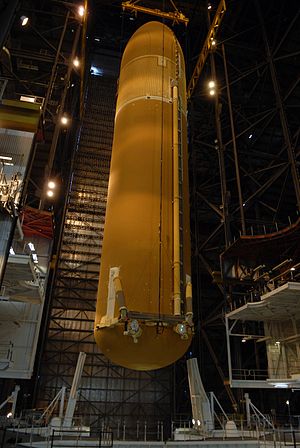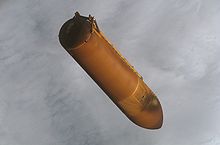 External tank No. 124 is lowered into high bay 1 of the Vehicle Assembly Building prior to attachment of the solid rocket boosters for mission STS-117. | |
| Manufacturer | NASA Michoud Assembly Facility, contractor: Martin Marietta, later Lockheed Martin |
|---|---|
| Country of origin | United States |
| Used on | Space Shuttle |
| General characteristics | |
| Height | 46.9 m (153.8 ft) |
| Diameter | 8.4 m (27.6 ft) |
| Gross mass | 760,000 kg (1,680,000 lb) |
| Space Shuttle ET | |
| Powered by | 3 RS-25 mounted on the orbiter |
| Maximum thrust | 1,254,000 lbf (5,580 kN)[1] |
| Burn time | 510 s |
| Propellant | LH2/LOX |

The Space Shuttle external tank (ET) was the component of the Space Shuttle launch vehicle that contained the liquid hydrogen fuel and liquid oxygen oxidizer. During lift-off and ascent it supplied the fuel and oxidizer under pressure to the three RS-25 main engines in the orbiter. The ET was jettisoned just over 10 seconds after main engine cut-off (MECO) and it re-entered the Earth's atmosphere. Unlike the Solid Rocket Boosters, external tanks were not re-used. They broke up before impact in the Indian Ocean (or Pacific Ocean in the case of direct-insertion launch trajectories), away from shipping lanes and were not recovered.[2]
- ^ Aerojet Rocketdyne, RS-25 Engine (accessed July 22, 2014)
- ^ "External Tank". NSTS 1988 News Reference Manual. NASA. September 1988. Archived from the original on August 19, 2019. Retrieved January 19, 2014.